At first glance the use of pungent substances in skin care sounds somehow strange. "Seasoning" a cosmetic or dermatological treatment has a legitimate and scientific background though, because the pungent components have a multitude of interesting properties. Pungency - origins and perception The perception of pungency results from the reaction of substances occurring in fruits, seeds, rhizomes or tubers, with the so-called nociceptors of the mucous membranes. Nociceptors are free sensorial nerve endings in the mouth, throat and nose area. They are sensitive to temperature rises and many chemical structures and initiate the sensation of pain. Associated with it is an intensified blood flow (dilation of the capillary vessels) in the respective tissue.
Other skin areas react with heat and a burning sensation to the contact with pungent substances - the sensation felt on the décolleté of course is stronger than on feet or palms since both are equipped with a thick horny layer.
The burning sensation on the skin and the pungent stimulus in the mouth area are intensified with warm water or hot beverages. The same effect can be observed when taking a shower after the application of anti-rheumatic ointments, even hours after the application. Sometimes this pain sensation feels like a burn or like touching a very hot object.
Pungent food causes heat sensations even when it is not heated. There is also a reverse effect, though: pungent substances can cause pain and an apparently cooling sensation instead of heat. Menthol can be cited as an example in this context. With regard to food it should also be mentioned that pungent spices can intensify the tastiness. Measuring the degree of pungency Most of the plants contain pungent substances in their above- and underground sections. Due to their low concentration, however, they often are not perceived as pungent but contribute to the typical taste of the plant.
Whoever has cultured chillies in his garden plot will know that different organisms have a different sensation of pungency. Just to mention an example: Habanero chillies with the pungency degree of 300,000 Scoville are consumed by snails and birds without objection. Consequently, the crop may be poor.
The Scoville scale refers to the content of capsaicin, the main pungent substance in chillies, red peppers and paprika. The scale ranges from 0 (0% of capsaicin) up to 16,000,000 Scoville (100% capsaicin). Based on the physical measuring of capsaicin content (HPLC), today it is possible to obtain accurate Scoville values. Former comparisons were based on serial dilution and hence were relatively inaccurate since pungency perception (irritation) and tolerance limit vary individually and an anesthetizing effect is built up with frequent intake of pungent food (anaesthesia means loss of sensory perception).
There are no comparable scales available for other pungent substances. Their content in plant sections is measured with chemical-physical methods. A comparison between the different pungency degrees also is inaccurate since structures and modes of action are varying. Capsaicin in cosmetic preparations? The anaesthetizing effect of capsaicin and a variety of similarly structured substances (capsaicinoids) that dock onto TRPV1 receptors also extends to the stimulus transduction from nerves to the small muscles below the skin surface. Resulting is a dilatation (relaxation) of the muscles adjacent to the mimetic lines and associated with it, a measurable wrinkle reduction - similar to a Botox treatment. This is why experiments were run with capsaicin-containing facial masks. It should however be mentioned that it needs getting used to because besides the warming sensation which only is pleasant with low concentrations, they also cause burning sensations and erythema. Needless to say that the sensitive eye area has to be completely covered up since already traces of the substances have strong irritant effects on the conjunctiva. That is why topical capsaicin applications are more or less limited to the already mentioned heat generating ointments or plasters for the pharmaceutical treatment of rheumatic diseases.
Capsaicin (8-methyl-N-vanillyl-6-nonenamide) has an amide structure (CO-NH):

Capsaicin Paracress It is an interesting fact that other acid amides also have relaxant properties which however are associated with considerably less pungency. Spilanthol alias (2E,6Z,8E)-N-Isobutyl-2,6,8-decatrienamide can be mentioned as an example here.
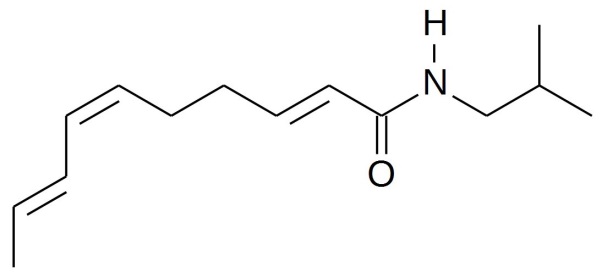
Spilanthol Spilanthol is a component of paracress extracts. Paracress is a tropical plant grown in South America, Africa and Asia. In Brazil it is called "jambú" and used as a vegetable. Similar to chilli peppers, paracress has a slight local anaesthetic effect. The effect is immediate, particularly if the extract is a liposomal formulation and hence can penetrate easily into the skin. The effect lasts for several hours and becomes weaker along with the degradation of spilanthol.
In the case of very sensitive skin there are sometimes reports of a transient light irritation and/or temporary erythema just like it is known from chilli extracts. Hence it is recommended to start the treatment with low doses. On the other hand, it turned out that with repeated application the dosage can be lowered while the effect remains the same. The advantage of paracress in contrast to botulinum toxin is that its effects are not based on toxicity. An accidental overdose is not critical, though.
Minor amounts of spilanthol also are contained in other extracts. Echinacea extract can be mentioned as an example in this context; it is used for the care of rosacea- and couperose skin. Mediterranean diet Since the ingestion of spicy food can cause sweating attacks, it is imaginable that it also is beneficial for the skin. This certainly is not a correct conclusion though. However, it is a fact that a Mediterranean diet or in other words, hot to pungent spices in combination with a relatively high consumption of (olive) oil contributes to a reasonable nutrition and last but not least takes care for an accelerated digestion. It is a well-known fact today that the condition of the intestinal microbiome has an impact on the skin. Only individuals suffering from rosacea should be careful since the increased blood flow can involve a temporarily intensified facial erythema.
The felt spiciness of a dish is considerably reduced by oils and other lipids but also by the ingestion of cheese. This is associated with an improved solubility of capsaicinoids in lipid phases and the amide linkage to the polyamide structure of proteins. Drinking water to minimize the pungency of dishes has counterproductive effects: thus capsaicin is stronger bonded to the gastric mucosa and the pungency hence is intensified. Ginger Similar to chilli & Co. ginger rhizomes and their spicy components, the gingerols but also the α,β-unsaturated shogaols that form when drying the rhizomes, are reported to provide a variety of healing effects among them pain-relieving, anti-inflammatory and anti-carcinogenic effects.
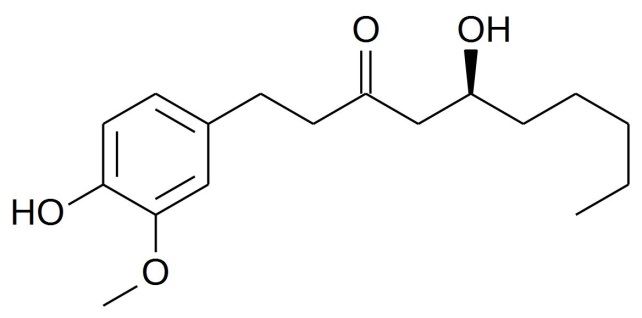 10-Gingerol
 6-Shogaol
(develops from 10-Gingerol) As with food supplements, besides the experiences of folk medicine also a multitude of studies are available for ginger extracts. The relevance of such studies however is difficult to judge since the studies often are based on in-vitro and animal models. Taking a look at the original statements regarding the different indications is recommended, though. Topical cosmetic applications of ginger extracts are focused on blemished skin and acne and hence on anti-inflammatory effects and such stimulating the blood flow. In this line of business, people tend to speak of a miracle drug that combines several properties in one single agent. Direct comparisons with other active agents are not available, though.
Ginger oil is gained through steam distillation and mainly has terpenoid components. Sometimes it is added to cosmetic preparations but in terms of effects on the skin it has no significance. Pepper The pungency of black and white pepper mainly results from piperin, a secondary amide:
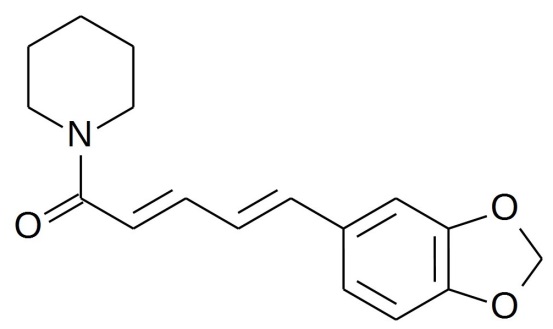
Piperin

Piperonal Piperin is related to piperonal (3,4-methylenedioxybenzaldehyde) which also is known under the term heliotropin and used to flavour laundry detergents and soaps but also applied as an alternative preservative for cosmetic creams. The preservative effect is based on the high reactivity of the benzaldehyde group on the one hand and the methylenedioxy group on the other hand which is a formaldehyde donor in acidic milieu. The latter mentioned also applies to the piperin of pepper so that the ingestion of larger amounts of pepper can lead to formaldehyde-caused damages when passing through the stomach (pH value just about 1). The elimination of formaldehyde explains why pepper has antimicrobial effects.
The manufacturing process of pepper oil which contains terpenes and sesquiterpenes is analogous to that of ginger oil. In combination with other oils, pepper oil is used as a room fragrance. Small amounts of pepper oil are sometimes added to rinse-off products such as soaps. It has nothing to do with pepper spray. The active agent in pepper sprays actually is capsaicin. Mustard The pungency of mustard seed, horseradish, wasabi and radishes but also of cabbage, cress and broccoli mainly is caused by glucosinolates. During metabolism and digestion they eliminate mustard oils alias isothiocyanates of different composition. R—N=C=S
Isothiocyanate
(R = organic molecule residu) The partly volatile sulphurous isothiocyanates are highly reactive compounds that irritate the skin and the respiratory passages similar to the non-sulphurous isocyanates used in expanding foams for construction purposes. For the same reason they have antimicrobial sometimes even antiviral effects. Ingesting larger amounts poses a risk for the health of humans.
Herbal extracts with a high amount of glucosinolates are not an issue in the cosmetic field, though. The identically named fatty mustard oil consisting of triglycerides of long-chained fatty acids and gained from mustard seed with cold-pressing process, by contrast, is used as cooking oil but also as a lipid component in cosmetic preparations or for massage purposes. The only thing that mustard gas has in common with the mustard family is its colour and its scent; it is used as a warfare agent. Garlic and onions Allicin is a pungent, sulphurous component of garlic forming from the amino acid alliin. It loses its pungency during processing particularly during heating. The same applies to the volatile and eye burning propanthial-S-oxide that forms from the amino acid isoalliin when onions are cut.
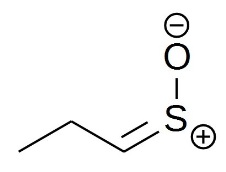
Propanthial-S-oxid
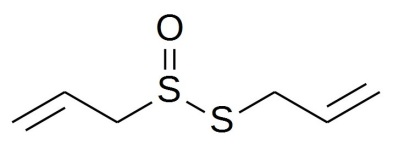
Allicin Although both the sulphur compounds are excellent antioxidants, the use of garlic- and onion extracts is limited to the food sector due to their irritant and olfactory properties. At a glance Pungent substances show very different compositions. Most dominant are α,β-unsaturated compounds, unsaturated sulphur compounds and above all amides. Amides are the most important functional group in the skin care- and dermatological sector. They penetrate easily and generally have an anti-itching effect. In this context also the endocannabinoid-like effect of fatty acid monoethanolamides should be mentioned which are used for the care of atopic skin.
Dr Hans Lautenschläger | 
